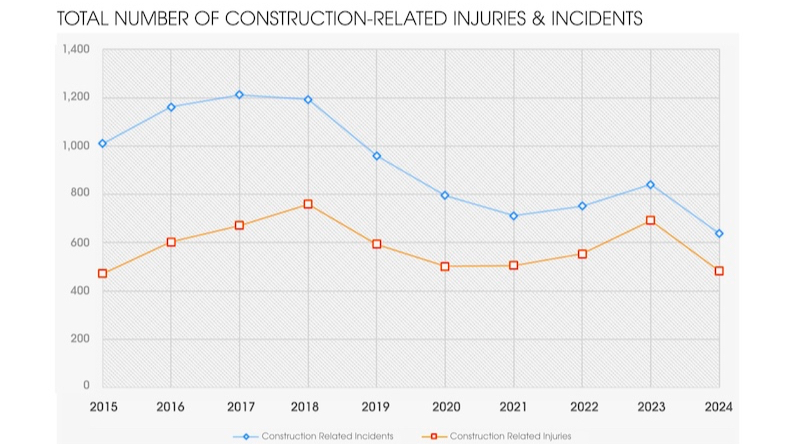Safest NYC Construction Sites in 10 Years
- eva_hatzaki
- Aug 21, 2025
- 3 min read
Mayor Adams and DOB Commissioner Oddo Release Annual Construction Safety Report.
Image: NYC.GOV/BUILDINGS
On April 25, 2025, New York City Mayor Eric Adams and Department of Buildings (DOB) Commissioner Jimmy Oddo unveiled the city’s 2024 Construction Safety Report —a landmark analysis showcasing unprecedented achievements in building site safety.
According to the report, worker injuries fell by an extraordinary 30%, declining from 692 in 2023 to 482 in 2024, marking a nine‑year low for such incidents. Similarly, construction‑related incidents dropped 24%, from 841 to 638, achieving a decade‑long low. The report also notes that worker fatalities remained at seven, matching the lowest annual total in 10 years, a sobering statistic underscored by the administration’s continued resolve.
416,290 DOB field inspections in 2024 — the highest number ever recorded.
Such safety milestones coincide with a surge in proactive oversight by DOB. In 2024, DOB conducted 416,290 field inspections, the highest number ever recorded, reflecting an aggressive enforcement strategy that prioritized compliance and vigilance.
These achievements stem from a suite of bold safety initiatives launched in recent years:
Stricter supervision of construction superintendents, limiting the number of jobs they oversee to allow more focused, site‑specific oversight.
New licensing requirements for operators of smaller hoisting equipment—such as mini‑cranes, telehandlers, and boom trucks—ensuring that operators are properly trained and certified.
Expanded use of digital technology, enabling contractors to maintain site documentation digitally via tablets or laptops—streamlining compliance and record‑keeping.
A “Worker Wallet” identification card, scannable and tied to specialized equipment training (scaffolding, rigging, mast climbers), reinforcing that only qualified personnel operate advanced machines.
A newly established proactive enforcement unit, backed by $4.7 million in funding and council legislation, which leverages predictive analytics to flag potentially hazardous sites and unsafe contractors before incidents occur.
Beyond enforcement, DOB has intensified communication with the construction industry by issuing advisories to worksites, holding regular safety‑focused meetings with contractors and industry groups, and fostering greater transparency across city government and the sector.
The report also highlights the vibrancy of New York City’s building sector. In 2024, initial permits for new construction projects surged by over 24%, with 103,592 permits issued—the highest total in five years—underscoring a thriving construction pipeline even as safety improvements take hold.
Important to note: over 98% of active construction sites reported no incidents or injuries in 2024, a testament to the collective impact of improved training, oversight, and technological tools.
Image: NYC.GOV/BUILDINGS
Mayor Adams praised the progress, stressing that “New Yorkers deserve safe workplaces… with inspections… at historic highs and incidents at a 10‑year low,” while reaffirming that “even one death… is unacceptable”.
DOB Commissioner Oddo echoed that sentiment, attributing these results to the effectiveness of safety initiatives, dedicated inspection teams, and industry collaboration—and vowing to continue pushing for even safer worksites.
Looking ahead, the DOB’s predictive‑analytics enforcement unit aims to proactively identify and inspect derelict buildings and unsafe contractors, thereby preventing incidents rather than reacting to them—continuing to safeguard New Yorkers as construction activity intensifies.
In sum, the 2024 Construction Safety Report reveals a city where bold governance, rigorous oversight, and collaborative industry practices are reshaping the construction landscape—delivering both record safety outcomes and an active, growing development pipeline. The challenge ahead lies in sustaining and building upon these gains, ensuring that every New Yorker—especially those on job sites—can return home safely each day.🀰








Comments